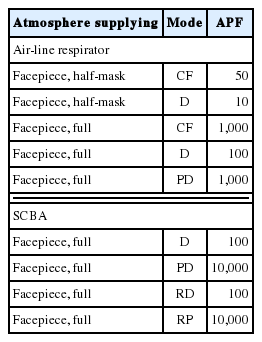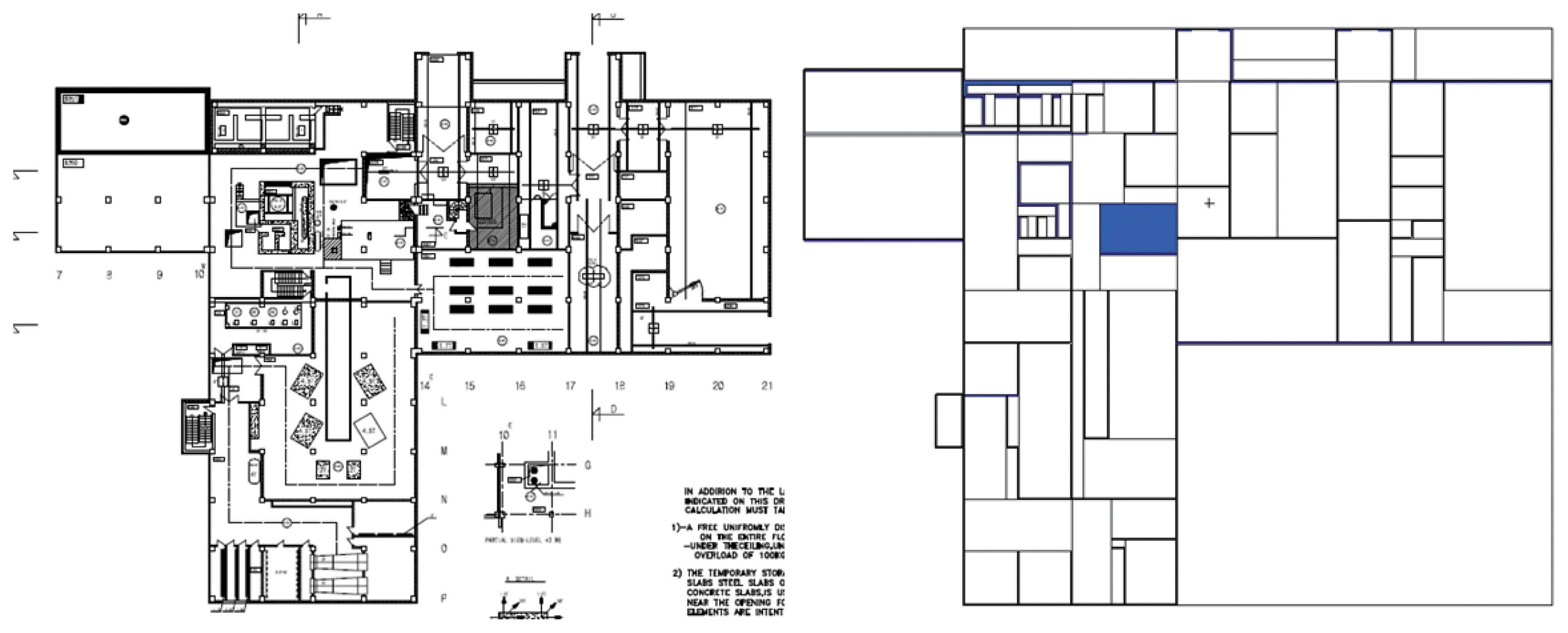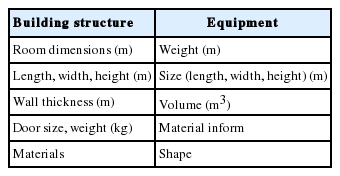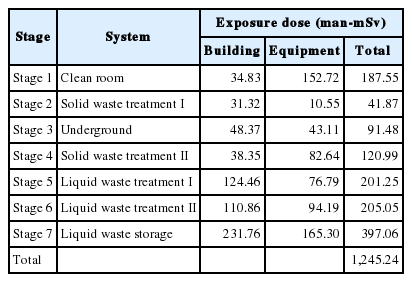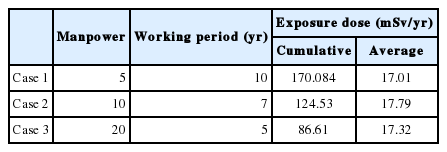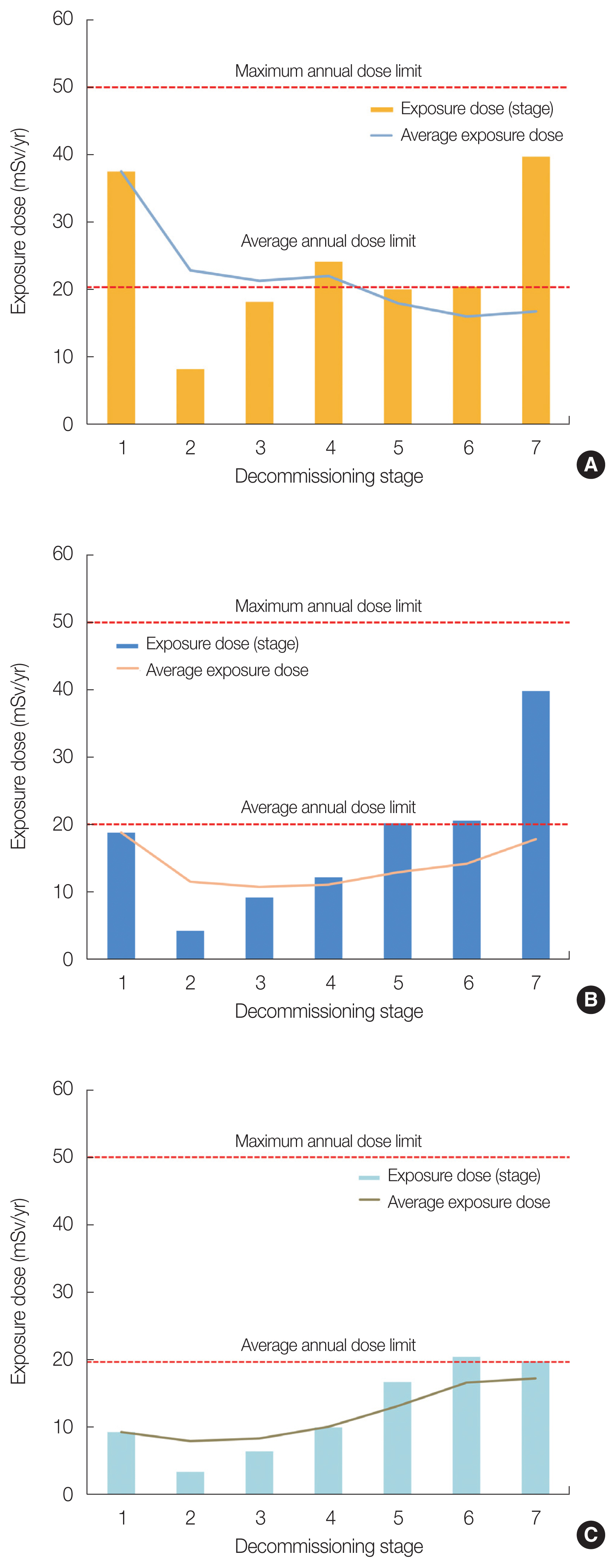An External Dose Assessment of Worker during RadWaste Treatment Facility Decommissioning
Article information
Abstract
Background
Kori unit #1 is permanently shut down after a 40-year lifetime. The Nuclear Safety and Security Commission recommends establishing initial decommissioning plans for all nuclear and radwaste treatment facilities. Therefore, the Korea Atomic Energy Research Institute (KAERI) must establish an initial and final decommissioning plan for radwaste-treatment facilities. Radiation safety assessment, which constitutes one chapter of the decommissioning plan, is important for establishing a decommissioning schedule, a strategy, and cost. It is also a critical issue for the government and public to understand.
Materials and Methods
This study provides a method for assessing external radiation dose to workers during decommissioning. An external dose is calculated following each exposure scenario, decommissioning strategy, and working schedule. In this study, exposure dose is evaluated using the deterministic method. Physical characterization of the facility is obtained by both direct measurement and analysis of the drawings, and radiological characterization is analyzed using the annual report of KAERI, which measures the ambient dose every month.
Results and Discussion
External doses are calculated at each stage of a decommissioning strategy and found to increase with each successive stage. The maximum external dose was evaluated to be 397.06 man-mSv when working in liquid-waste storage. To satisfy the regulations, working period and manpower must be managed. In this study, average and cumulative exposure doses were calculated for three cases, and the average exposure dose was found to be about 17 mSv/yr in all the cases.
Conclusion
For the three cases presented, the average exposure dose is well below the annual maximum effective dose restriction imposed by the international and domestic regulations. Working period and manpower greatly affect the cost and entire decommissioning plan; hence, the chosen option must take account of these factors with due consideration of worker safety.
Introduction
In June 2017, Kori unit #1 was permanently shut down after 40 years of successful operation. According to the Nuclear Safety and Security Commission (NSSC) Notification 2015–8, a utility should establish a decommissioning plan, and Kori unit #1 had adopted decommissioning after approval by the NSSC. The nuclear industry of Korea begins the decommissioning stage. Not only nuclear power plant (NPP) but also an institution that has a nuclear fuel cycle facility prepare the initial and final decommissioning plan [1–5].
In the initial decommissioning plan, institutions should provide radiological characterization, exposure scenarios, and paths. The decommissioning plan consists of 11 chapters, and safety assessment provides in Chapter 6 [6]. Chapter 6 is organized by 6 subsections: (1) principles and standards, (2) scenario, (3) assessment of exposure, (4) residual radioactivity, (5) abnormal events, and (6) risk assessment, which provide radiation effect to the worker, resident, and environment. Especially, there would be a concern about the radiation impact on workers, because decommissioning spent more than 10 years before it was remedial or re-used in contaminated sites. Therefore, it is required to evaluate the risk for radiation workers due to an appropriate decommissioning plan should be established.
The external exposure dose was considered by exposure scenario, decommissioning strategy, and working schedule. In this study, the exposure dose includes only external exposure except for internal exposure. Because this paper considers only normal situation which is that worker prepares radiation protection equipment by the regulation. The respiratory prevention ability of radiation protection equipment is shown in Table 1 [7]. We define parameters for evaluation of the physical and radiological characterization to set up the decommissioning strategy, and external exposure dose was calculated following the decommissioning strategy. The optimal working schedule that will prevent the overexposure of decommissioning workers, can be derived from safety assessment. Therefore, we suggest a working schedule for the radiation worker to satisfy the limitation of regulation.
Materials and Methods
1. Analysis of the Elements for Assessment of Exposure Dose during the Decommissioning
1) Define the exposure dose and annual dose limit regulation during the decommissioning
In the International Atomic Energy Agency (IAEA) Safety Guide (No. RS-G-1.8; Standard Environmental and Source Monitoring for Purposes of Radiation Protection), the main pathways of radiation exposure are defined for external and internal exposure. For the external exposure, four of pathways are presented; direct exposure from a source of ionizing radiation, exposure due to plume of radionuclides in the atmosphere and the water, contact exposure from radionuclides on the skin, and exposure from radionuclides deposited on the ground, on sediments, building surface and vegetation. Also, there are four pathways for internal exposure; inhalation of radionuclides in a plume, ingestion of radionuclide in food or beverages, absorption through the skin for tritium oxide in the plum and inhalation of re-suspended radionuclides from contaminated soil or sediment. In the decommissioning of the nuclear facility, exposure pathways are restricted to three pathways in the dose evaluation. Also, these pathways are divided into external and internal exposure. The external exposure is contact exposure from radionuclides on the skin and deposited on the building surface contamination. The internal exposure is the pathway which is intake by the respiration during the decommissioning works. However, in this research, total exposure dose only considers external exposure, because internal exposure can rarely occur in normal events due to disuse alpha isotopes in RadWaste Treatment Facility (RWTF) and an introduction of the enhanced personal radiation protection system. Internal exposure occurs when worker intake by respiration of airborne radioactive material. In a normal situation, airborne release fraction for decommissioning or decontamination is very low, and radiation protection equipment is an effective defense from airborne particles [8].
To establish the decommissioning plan and assess the exposure dose, the annual permissible dose limits of various institutions including Korea were analyzed proactively. Most annual permissible dose limits are based on the International Commission on Radiological Protection (ICRP) Publication 60 recommendation, but in some countries, there are some differences. The European Union (EU) stipulated the dose limit according to the recommendation of the basic safety standard guide following the ICRP Publication 60, also, Korea explicitly stipulates the “standard for radiation protection” based on the ICRP Publication 60 [9]. However, the Korea Atomic Energy Research Institute (KAERI) stipulates a 15 mSv/yr lower than “standard for radiation protection” in the Korean government due to secure safety by a margin of 20%. The United States stipulates the dose limit for radiation workers as a maximum of 50 mSv/yr based on the Code of Federal Regulations (10 CFR Part 20) but does not apply the 5 years effective dose limit [2]. To establish the decommissioning plan, this study stipulates the dose limit for workers as average 20 mSv/yr, a maximum of 50 mSv/yr and a 5-year effective dose limit as 100 mSv. Table 2 shows the dose limit for radiation workers in different countries and institutions.
2) Decommissioning strategy of RWTF
For assessment of the exposure dose to workers, the anticipated decommissioning activities at each stage are defined according to the decommissioning strategy derived from the decommissioning strategy and method, and the exposure dose to each decommissioning activity is evaluated.
A decommissioning strategy is made by two rules: “out to in” and “cold to hot”, which means that decommissioning progress from low activity to high activity [10]. The decommissioning strategy has a working plan which is a combination of decontamination and dismantling strategy of several rooms. The decommissioning procedures of RWTF consist of 7 stages, which are shown in Fig. 1: (1) clean laboratory sector, (2) equipment carry-in sector, (3) solid radioactive waste treatment sector I, (4) solid radioactive waste treatment sector II, (5) liquid radioactive waste treatment sector I, (6) liquid radioactive waste treatment sector II, (7) liquid radioactive waste storage sector. Fig. 1 shows that the greenhouse and specific cutting booth should be installed for securing radiological safety before the radioactive waste treatment sector is decontaminated. Therefore, it is established to make uninfluenced by radiation emitted from other equipment or sectors. In this paper, in consideration of these conditions, the exposure dose of the worker was evaluated at each stage.
3) Physical and radiological characterization
To evaluate the exposure dose of workers, the physical and radiological characterization should be analyzed. In this section, the physical and radiological characterizations were shown for dose assessment. The evaluation methods of physical characterization of RWTF are as follows [1].
First, the name, capacity, quantity, size, specific gravity, volume, weight, and material of the object for the building structure and equipment were collected. Second, the 3D modeling of the RWTF is composed through the facility drawings in MCNP code which is widely used in particle energy transfer simulation, and which shows the total volume and mass by including material from each compartment using material input data [11]. The volume and mass of each room were measured, and the amount of concrete in each layer was calculated by multiplying the specific volume of normal concrete and heavy concrete by volume. The 2D modeling by each floor is simulated, and the 2nd floor is shown in Fig. 2. And 3D modeling of RWTF is shown in Fig. 3. In the case of physical inventory of equipment, the weight and size of equipment were obtained from standard documents. The parameters for physical characterization evaluation are shown in Table 3.
Radiological characterization used Radiological Safety Control Report (KAERI/MR-584-2015) [12] which is measurement reports of ambient doses and dose rates and radioactivity concentrations monthly at each facility of KAERI. This report shows the safety of the nuclear facility operational manual of KAERI and it secures nuclear facility and researcher to achieve the ALARA (as low as reasonably achievable). In the reports, ambient doses and dose rates were measured maximum and the average value in 6 groups which integrate several sectors, which can be represented the contamination value of each sector. In this research, the maximum value of measurement results is used to evaluate conservatively.
Results and Discussion
1. Exposure Dose Assessment of Worker during the Decommissioning
1) Exposure dose assessment during the decommissioning works
The decommissioning activity consists of building decontamination and dismantling of equipment, and building decontamination includes wall decontamination and monitoring of each room.
The direct external exposure is caused by gamma rays emitted from the dust generated from the surface of the wall and equipment during decontamination and decommissioning (D&D) activity. The direct exposure dose which is causing by other steps was neglected because of the shielding effect by the installation of the greenhouse. The calculation model for exposure dose evaluation was developed and the formulas of effective dose evaluation are presented according to the main exposure sources. The external dose of workers by contaminated air and surface is evaluated by the following equation (1).
where EDCD is total external exposure dose for the worker (collective dose, man-mSv); Qit, quantities of the D&D work item (m2, m3, kg); PFit, productivity factor of the item (man-hr/unit [m2, m3, kg]) as shown in Table 4; Dad, ambient dose rate (mSv/hr).
PFit is a productivity factor that includes work difficulty factor (WDF) depending on each activity, which derived from experiences of decommissioning of the Korea Research Reactor 1 (KRR-1), KRR-2 and the Uranium Conversion Plant (UCP) in the KAERI. Dad is a maximum data of a monthly measurement ambient dose.
The detail external exposure dose according to decommissioning stages was shown in Table 5. In Table 4, the external exposure dose of the worker during the decommissioning activity is a total of 1,245.24 man-mSv with maximum ambient dose at each room. Although the decommissioning activity of stage 1 was performed in the clean laboratory, the exposure dose of stage 1 shows the 187.55 man-mSv. The total external dose influenced by the quantity of D&D work item shows the very high exposure level, because step 1 includes massive equipment such as tong box in the “storage before decontamination α, β, γ treatment room”. In this case, for the control the exposure of a worker, working schedule and manpower has to be managed. Excepting stage 1, Table 5 shows that the external dose increases with the stage, which means that the decommissioning strategy was designed well by the rules. According to dose assessment, systematic management of external exposure dose by control the working schedule and manpower of the worker is necessary.
2) Optimization of working schedule by exposure dose assessment
Following the exposure dose assessment, the working schedule can be managed flexibility. The working schedule is affected by working period and manpower, and exposure dose by control the working schedule should be under the total exposure dose for 5 years and annual maximum dose limit. To satisfy the limitation of regulation, Table 5 shows the average exposure dose and accumulative exposure dose by variation of the working period and manpower; (1) 5 workers a year for 10 years, (2) 10 workers a year for 7 years, and (3) 20 workers a year for 5 years. The results of exposure dose assessment are shown in Table 6 and Fig. 4. Table 5 and Fig. 4 show the tendency of the exposure dose with the decommissioning strategy by the working period and manpower. In Table 5, all case 1, 2, and 3 show what achieve about 17 mSv/yr under the regulation limit. However, Fig. 4A and 4B show overexposure of workers with an average annual dose limit at stage 5, 6, and 7. In this case, the worker engaged on-site during stages 5, 6, and 7 should be managed strictly to keep a maximum annual dose limit. Therefore, restructuring of additional workers is needed, which can affect the decommissioning plan including the cost. Therefore, utility or institutions which have a nuclear facility should consider the optimization of the decommissioning plan following exposure dose assessment and legal requirements.
Conclusion
In this study, the external exposure dose is evaluated as a part of the safety assessment. To assess the safety of decommissioning workers during the decommissioning process, it requires analyzing the decommissioning strategy and information of the decommissioning facility. The decommissioning strategy is set up based on the ambient dose at each sector, and physical and radiological characterization is analyzed using construction drawings and official documents from KAERI. Using this information, the exposure dose of workers is calculated at each stage, if 10 workers on two-shift a day take 5 years to decommission the RWTF, and it has a 17.32 mSv/yr under the limitation of regulation for an effective dose of the radiation worker. Also, 5 workers on two-shift a day for 7 years can achieve a 17.78 mSv/yr under the limit of regulation. Therefore, according to the external exposure assessment, we can manage the working period and manpower more flexibility, which can influence the cost.
As a result, the evaluation results show that the calculation method of this research is expected to be utilized in the decommissioning planning. Although, it is valuable work to establish the decommissioning plan and protect the decommissioning worker, the assessment of the exposure that may occur as a result of actual during the decommissioning process should be implemented and added.
Notes
Conflict of Interest
No potential conflict of interest relevant to this article was reported.
